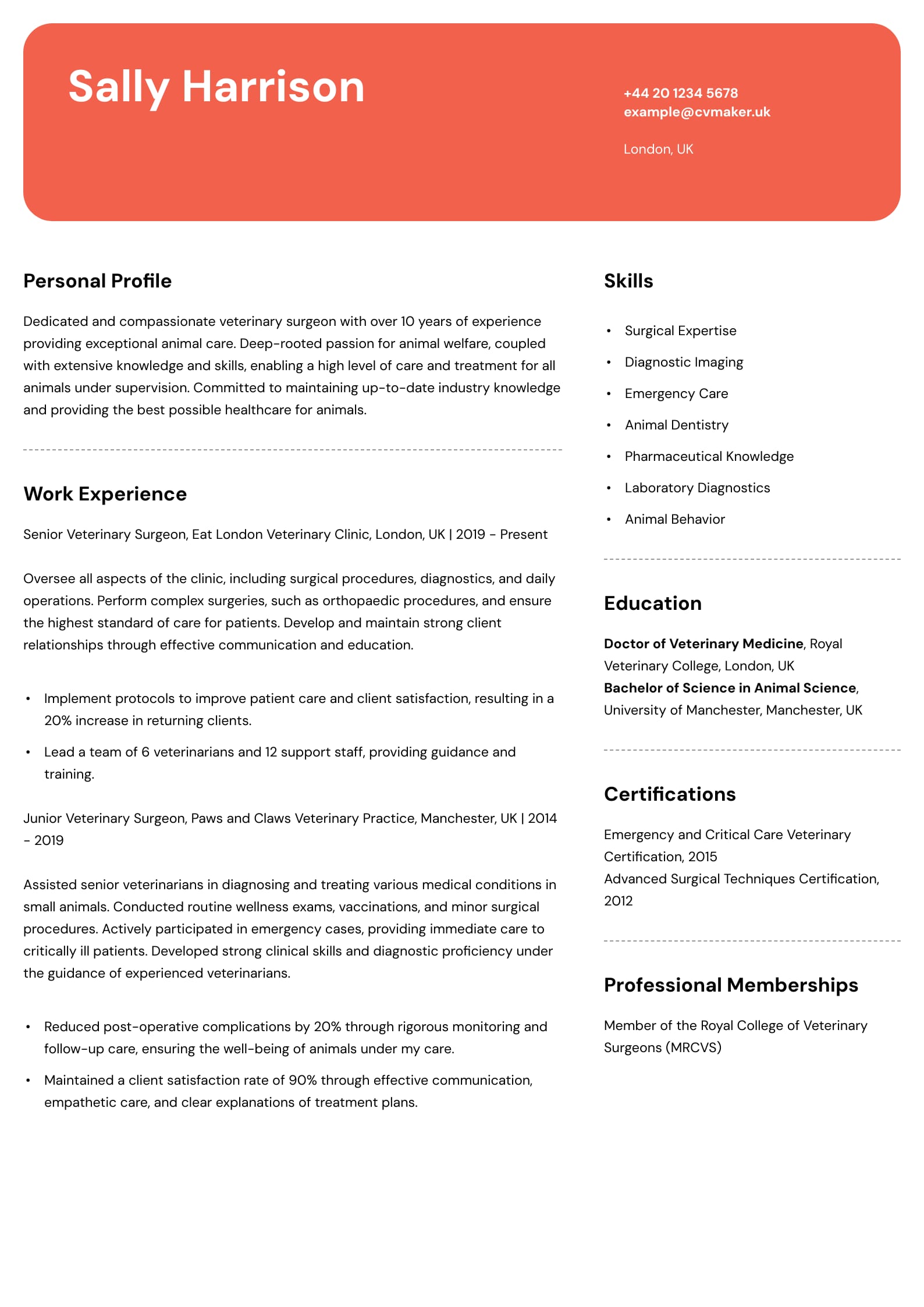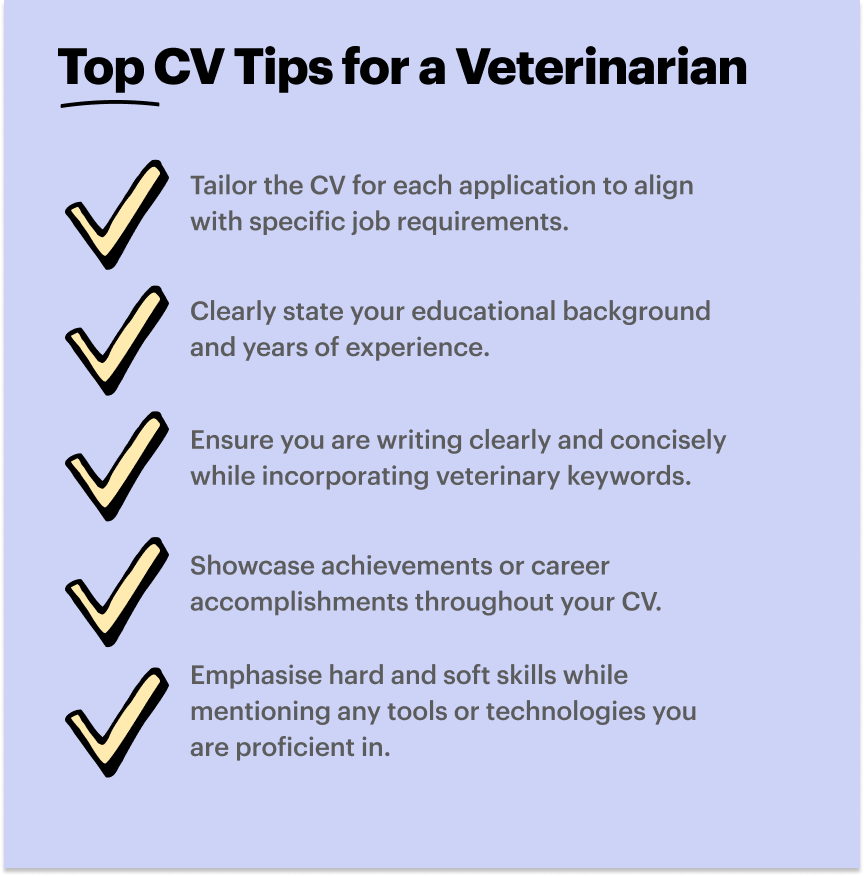How to Write a Standout Veterinarian CV: A Step-by-Step Guide with Best Practices
Veterinary medicine is a rewarding and diverse field – demanding not just technical skill but a compassionate approach to animal care. If you’re aiming for your next role, creating a professional veterinarian CV is your gateway to new opportunities. This guide brings together proven strategies, practical examples, and insights from latest industry trends to help you craft a credible application. We’ve included the latest advice from trusted sources like the Royal College of Veterinary Surgeons, Vet Record Jobs, and leading recruitment platforms.
In this article, we dive into:
The essential elements of a modern CV.
How to stand out in the competitive veterinary field.
What to look out for with your job search.
Tips for those starting out.
Streamline your CV writing process with CVMaker, featuring intuitive designs and advice on how to choose the best CV template.
Customise this vet CV example
Vet CV example
 Download this sample of a veterinarian CV in PDF
Download this sample of a veterinarian CV in PDF
This CV example features Sally Harrison, an established veterinarian with 10 years of proven success in providing exceptional animal care. She has opted for the two-column Erasmus template to clearly and concisely show her career growth, areas of expertise, and education.
What to include in a vet CV?
A well-organised CV layout is crucial for readability and for making an impression with employers and applicant tracking systems (ATS). Use clear sections and bullet points to ensure your veterinarian CV stands out:
Personal information: Full name, contact details, LinkedIn profile (keep your online presence updated), and current location – enough for initial contact.
Personal profile: A short, tailored statement summarising your qualifications, key skills, and what sets you apart as a veterinary professional.
Key skills: Highlight both your clinical and soft skills (e.g., animal handling, diagnostics, client communication, teamwork).
Work experience: Detailed but concise accounts of your previous veterinary roles, arranged in reverse chronological order. Include your achievements, not just duties.
Education and certifications: Degrees, professional qualifications, and relevant continuing education (e.g., Royal College of Veterinary Surgeons registration, CPD courses).
Professional affiliations (optional): Memberships with organisations such as the British Veterinary Association.
Additional sections: Volunteering, research, presentations, or animal including community outreach.
Must-have CV sections
Personal profile
Skills section
Work experience
Education
Learn more about how to write a good CV.
Writing a strong veterinarian CV personal profile
Start with a focused personal profile that captures your strengths and career goals. This short paragraph is your opportunity to show you understand the veterinary profession and can deliver high standards of animal care. Follow these steps:
Tailor it to the job you are applying for.
Showcase your unique selling points.
Incorporate keywords from the job description.
Keep it clear and concise.
Personal profile on a CV
Whether you are a student, a graduate, or a seasoned professional, a personal profile is essential for your CV when targeting the UK job market. This statement should grab the attention of employers and set you apart from other applicants.
Learn more about how to successfully pitch yourself in a personal profile.
Veterinary Surgeon CV Personal Profile Example
Experienced veterinary surgeon dedicated to providing top-notch care for animals with 10+ years of proven success. Proficient in medical diagnosis, surgical procedures, and preventive healthcare. Committed to staying updated with the latest industry advancements and maintaining a strong rapport with pet owners.
Veterinary Assistant CV Personal Profile Example
Enthusiastic veterinary assistant with a passion for animal welfare. Skilled in providing support to veterinary professionals, handling animals, and maintaining clinic operations. Excellent communicator with a caring attitude toward both animals and their owners.
Wildlife Vet CV Personal Profile Example
Wildlife veterinarian with a strong conservation mindset. Specialised in the treatment and rehabilitation of wild animals. Committed to preserving biodiversity and actively engaged in fieldwork to protect endangered species.
Vet Student CV Personal Profile Example
Aspiring veterinary student eager to embark on a career in animal healthcare. Enthusiastic learner with a strong academic background in biological sciences. Driven to gain hands-on experience and contribute to improving animal health and welfare.
Pro Tip
Tailoring your CV to the specific vet position you're targeting will maximise its impact and relevance. Include soft skills from the job description to make your CV stand out.
Boost your CV with the best vet skills
Besides being highly skilled in veterinary medicine and animal nutrition, a good vet should have interpersonal skills such as strong work ethic, high emotional intelligence, communication skills, and empathy. When creating a professional veterinarian CV, present your skills in a clear, scannable layout – ideally as a bulleted list. Review job descriptions to ensure you match key requirements. For more tips, refer to key skills to put on a CV.
Use your personal profile to showcase soft skills in action
"Compassionate and adaptable veterinary surgeon with strong attention to detail and a proven ability to deliver high-quality care across busy clinical settings, while working closely with veterinary nurses, pet owners, and multidisciplinary teams."
| Hard skills | Soft skills |
|---|---|
| Animal welfare | Patience |
| Advanced surgical procedures | Compassion |
| Treatment plans | Motivation |
| Laboratory diagnostics | Adapatable |
| Critical care | Passionate |
| Medicine administration | Meticulous |
You can also integrate these skills into your experience section
“Assisted in surgical procedures and post-op care, contributing to faster recovery times and improved client satisfaction.”
Showcase relevant veterinarian experience
Employers want to understand your practical skills and see real results. Structure each entry with your job title, employer, location, and dates. Focus on contributions and quantifiable outcomes. Whether you started your career as an assistant, student, or have a few years of experience, writing each entry in just a few lines is always challenging.
What should each work experience entry include?
Job title of current or previous role
Organisation name and location
Dates of employment (month/year)
A concise paragraph detailing your duties
Followed by 2–3 bullet points that highlight your key achievements or measurable impact.
Learn more about the work experience section in a CV.
In the end, the goal is to provide a brief overview of your responsibilities and contributions in the form of achievements.
Good versus bad achievement examples for your vet CV
Good
“Performed pre-op assessments and monitored anaesthesia for over 50 surgical procedures with a 100% recovery rate.”
Bad
“Helped with surgeries.”
Good
“Led a vaccination outreach programme, increasing local pet registration by 25% over three months.”
Bad
“Gave vaccines to pets.”
Good
“Developed post-operative care plans that reduced follow-up visits by 30% and improved client satisfaction scores.”
Bad
“Looked after pets after surgery.”
Examples of work history entries for a vet CV
Veterinarian Graduate, Belfast Animal Hospital, Ireland | 2022 - 2023
Assisted senior veterinarians in diagnosing and treating a variety of animal cases. Administered vaccinations and medications, maintaining detailed records for each animal. Educated pet owners on health, nutrition, and preventive care. Collaborated with a team of veterinary professionals to deliver exceptional service.
Achieved a 15% increase in vaccination compliance among pet owners by implementing a proactive reminder system, resulting in better disease prevention and animal health.
Implemented a digital record-keeping system, reducing record retrieval time by 30% and enhancing clinic efficiency.
Vet Nurse, Paws and Claws Veterinary Clinic, London | 2020 - Present
Provide comprehensive animal nursing care, including monitoring vital signs, administering medications, and wound dressing. Assist veterinarians in surgeries, ensuring proper equipment sterilisation and patient preparation. Maintain a clean and organised environment, ensuring the safety and comfort of animals and staff.
Educated more than 100 pet owners on pet health and preventative care, leading to a 20% increase in client compliance with recommended treatments and protocols.
Received two team recognition awards for maintaining a consistently clean and organised clinic environment, improving the overall patient and staff experience.
Student/Volunteer Animal Care Assistant, Happy Tails Animal Shelter, Birmingham | 2020 - Present
Support daily care and well-being of shelter animals, including feeding, grooming, and exercise. Collaborate with veterinary staff to administer treatments and medication as directed. Assist in organising adoption events and helped prospective pet owners find suitable animals. Maintain accurate records and contributed to creating a safe and clean environment for animals awaiting adoption.
Improved shelter animals' overall health and well-being by implementing a customised feeding and exercise program, resulting in a 15% increase in their overall vitality and adoption rates.
Played a vital role in organising and executing 25+ successful adoption events, placing 100+ animals into loving homes and reducing shelter overcrowding.
If you are a veterinary student with little to no experience, refer to our article on how to write a CV with no experience.
Pro Tip
Don't underestimate the value of volunteer work! Whether you helped at an animal shelter, wildlife rescue, or assisted a local vet, it shows commitment, hands-on experience, and passion – especially important if you're a new graduate or career switcher.
List veterinarian education or certifications
If you are seeking to specialise, a degree is required. The highest form of qualification to becoming a vet is a Doctor of Veterinary Medicine degree. If you are looking for alternative careers that do not require a degree, look into becoming a veterinary nurse, zookeeper, or wildlife safari tour guide. For more information, refer to how to write education on a CV.

Explore available courses and certifications for veterinarians in the UK:
Pro Tip
Emphasise qualifications aligned with your target role by incorporating relevant courses or projects to enhance your degree or professional training.
Key takeaways
Writing a CV can be time-consuming and stressful, especially if you're a recent student entering the workforce or changing careers. This guide provided key insight and expert advice on landing your dream job with a great CV! Let’s break it down into five key points.

For different CV formats or templates, consider the following:
FAQs
How much does a vet earn in the UK?
In the UK, the earnings of a vet can vary depending on factors such as experience and location, but on average, a veterinarian can earn around £30,000 to £60,000 per year. For more information, check out the article by The UKCAT people.
Is a vet a doctor in the UK?
Yes, in the UK, a vet is called a "veterinary surgeon" and holds the Doctor of Veterinary Medicine (DVM) title.
What is the role of a vet in the UK?
It primarily involves the diagnosis, treatment, and care of animals. Furthermore, it includes conducting medical examinations, performing surgeries, prescribing medications, and advising on animal health and welfare.
What are vets called in England?
In England and the rest of the UK, veterinarians are commonly called vets or veterinary surgeons.
How do you qualify as a vet in the UK?
Individuals typically need to complete a Bachelor of Veterinary Medicine and Surgery (BVMS) or a similar degree accredited by the Royal College of Veterinary Surgeons (RCVS). After completing the degree, they must undergo practical training and pass the RCVS membership examinations.
How long is vet school in the UK?
Vet school in the UK typically takes about 5 to 6 years to complete, including the undergraduate degree program and the required practical training and examinations.






)

)
